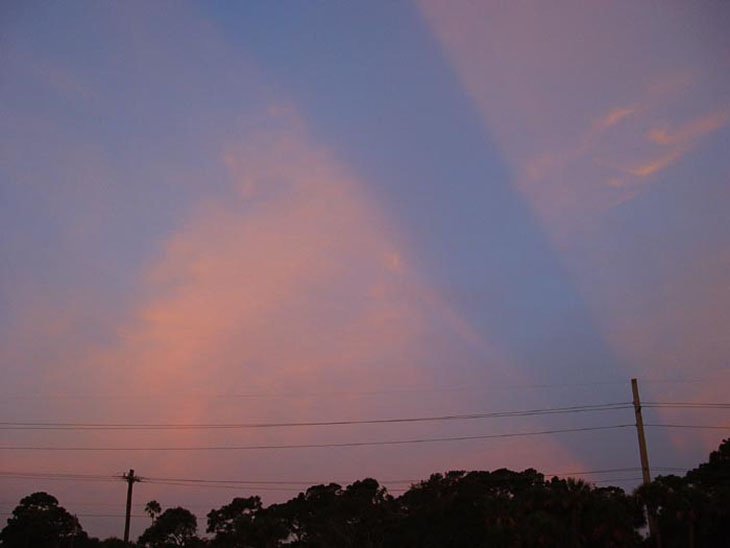Perspective, in the usage of considering some topic from a different standpoint than originally, is a great thing, and something I play with a lot on this blog. In the usage of how things appear to us visually, based on our position, it’s a useful thing to play with in photography as well. But sometimes, it’s hard to override our mental perspective to recognize the visual one.
 Crepuscular rays are the beams of light, typically from the sun, that emerge from a break in the clouds to throw a spotlight effect someplace – we can generally make them out because of the humidity and dust in the air being illuminated. My example seen here is almost the opposite, being a shadow thrown by the cloud blocking the sunlight, but essentially the same effect. Taken at sunrise, there needed to be several conditions in place to see this. The first is a high-altitude layer of clouds forming a screen across the sky. The second is the lower cumulus cloud, the puffy one in the image, which is hundreds or perhaps thousands of meters lower that the screen layer. And of course the sun had to be very low on the horizon so that its light would not only be thrown upwards against the underside of the screen layer, but also blocked by the puffy cloud.
Crepuscular rays are the beams of light, typically from the sun, that emerge from a break in the clouds to throw a spotlight effect someplace – we can generally make them out because of the humidity and dust in the air being illuminated. My example seen here is almost the opposite, being a shadow thrown by the cloud blocking the sunlight, but essentially the same effect. Taken at sunrise, there needed to be several conditions in place to see this. The first is a high-altitude layer of clouds forming a screen across the sky. The second is the lower cumulus cloud, the puffy one in the image, which is hundreds or perhaps thousands of meters lower that the screen layer. And of course the sun had to be very low on the horizon so that its light would not only be thrown upwards against the underside of the screen layer, but also blocked by the puffy cloud.
We tend to throw around phrases like the sun being “within the clouds” or such, going with what it appears to be rather than the reality of it being 150 million kilometers away from the planet, “above” everything. So here it’s not even below the clouds, but the planet and the clouds immediately above my head as I took this were in a very narrow set of acceptable angles, letting the sun’s light under a narrow gap off to the side, changing as the planet rotated and the sun “rose.” In fact, I can’t help when writing this but to think of a quote from Douglas Adams, in Life, The Universe, and Everything: “Several billion trillion tons of superhot exploding hydrogen nuclei rose slowly above the horizon and managed to look small, cold and slightly damp.”
But even the apparent spreading of crepuscular rays, or in this case a crepuscular shadow, is an illusion akin to the convergence of the road edges or train tracks as they trundle off into the distance, since the edges are parallel. Or very nearly. The sun is a hell of a lot larger than the Earth, and all parts of its surface are emitting light. So while light from the center of its face is throwing a shadow in one direction, light from the left edge is throwing a shadow in another direction, and so is the right, and every point in between all of them, resulting in a shadow with a dark central portion that gets narrower with distance, but diffuse edges that get broader. It looks like this:

… except that, because of the very limited range of it we can see and the enormous distance of the light source from the Earth, we can essentially call the shadow edges parallel. While the angle will reduce with distance, the sun will never become smaller than the Earth and so the edges will not change in nature. Crepuscular rays appear so distinctly to be spreading only because the “wider” part is a lot closer to us than the origin at the cloud or mountain pass or whatever. You’ve undoubtedly seen more pronounced examples than what I’ve used here, and just keep it in mind that they are not really broadening, merely uniform stripes with (more or less) parallel edges.
But I used the top image for a reason, and that is, I also turned the other way and got a shot of the shadow disappearing over the opposite horizon, which illustrates the illusory nature of the phenomenon (and also, for trivia’s sake, called anticrepuscular rays.) Now, the edges seem to be converging back down, or thrown by another light source coming from the opposite direction:

If you think the fingers of shadows flanking it are that edge diffusion effect, remember that the light source is behind you now, and they should be going the other way. Instead, they are additional shadows thrown by other bumps on the cumulus cloud, becoming visible because the screen layer is curving downwards around the planet. Thinking two-dimensionally in this case is only going to be misleading.
This is all interesting by itself (well, I think so anyway,) but it also parallels situations I see all too often. When dealing with topics such as paranormal experiences, home medical remedies, or even gambling formulas, personal experience is one of the most prominent arguments in support; the trump card is, “I know what I saw” (or felt, or heard, or experienced in whatever way,) the undeniable firsthand evidence. Yet, there is a difference between the raw input of our senses and our interpretation of them – often colored by things we’ve heard from other sources. “Look! An alien spaceship!” Well, no – it’s a light in the night sky, at an unknown distance and moving, perhaps, at an unknown velocity because it’s not possible to determine speed without knowing distance. The ISS, crossing overhead at nearly 30,000 kilometers per hour, appears to be magnitudes slower than a news helicopter that cannot top 225. Mars, Jupiter, and Sirius all appear the same size to us, despite their vast differences in mass and distance. And of course, when someone is told they’re in a haunted location and inclined to believe it, every odd sound, every shadow seen peripherally, is simply more positive evidence. Most amusing about this is when someone who isn’t inclined to believe finds nothing out of the ordinary from the same experiences, they’re often accused of being dismissive or closed-minded – apparently you can be biased against evidence but not somehow for it.
Do these images make a case against paranormal phenomena? Does any optical illusion demonstrate that someone has misinterpreted their experience? Of course not. Yet, it does show that what we think we see and what’s really there are often different, and the true nature of having an open mind is not belief, but accepting that things are not always as our initial impressions portray.




















































